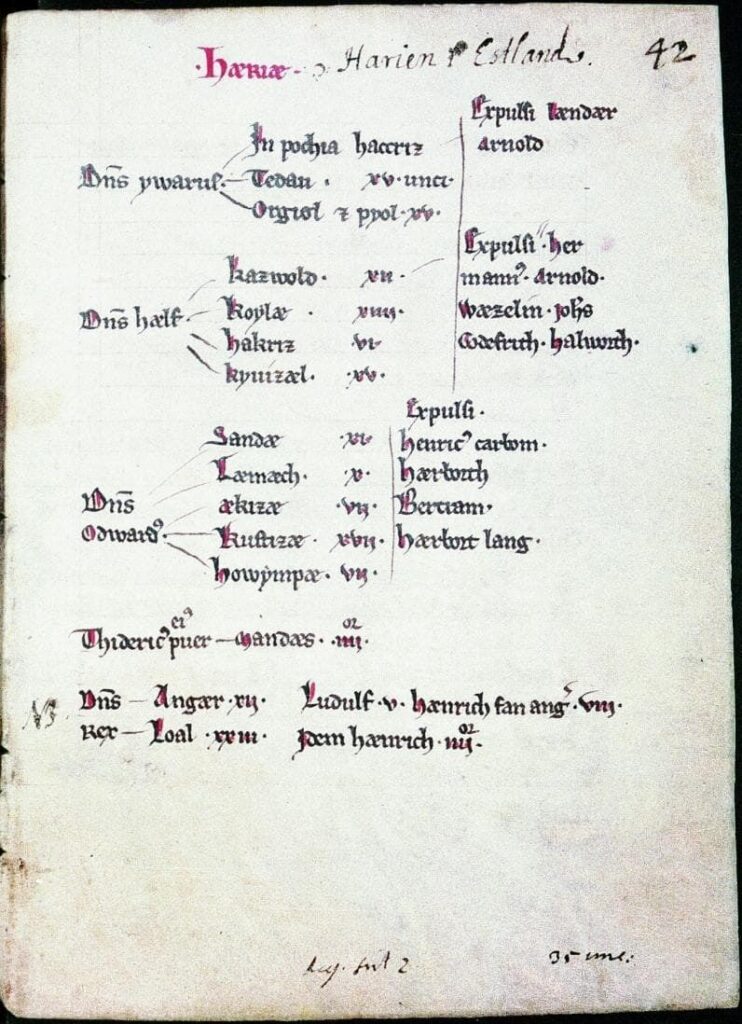Mihkel Mäesalu & Stefan Pajung
There are limits to historical knowledge, especially when studying periods so distant as the 13th or 14th century. The sources of information – chronicles, charters, documents etc. – dating from this period are rather scarce for both Denmark as well as Estonia. It is therefore often the case that we can raise more questions than we have answers for. In this month’s blogpost we describe one such situation. A research question we have not managed to answer due to lack of sources.
The question itself was such: could at least some Danish royal vassals in Northern Estonia under Danish rule (1219–1227 and 1238–1346) have resided in Denmark? It is quite certain that the majority of the royal liegemen of Danish Estonia did in fact live there. At the same time one can imagine, that there may have been some exceptions. It is possible to argue, that a royal liegeman holding large fiefs in Danish Estonia could have lived in Denmark and administrated his fiefs through men in his service.
The Estonian list in King Valdemar’s Survey, composed probably around 1240, lists 10 liegemen of the Danish king in Northern Estonia with indisputably Scandinavian names. According to Paul Johansen’s thorough study of the Estonian list, published in 1933, six of those men settled in Estonia, whereas four – Ivar, Knud, Tuki Wrang and Hælf Gutæ – did not. Johansen assumed that these four men sold or relinquished their fiefs in Estonia and returned to Denmark.
These four men held quite large fiefs in comparison with the majority of the royal liegemen. Tuki Wrang had 118 ploughlands, Ivar 81, Hælf Gutæ 78 and Knud 53. We might label them as belonging to the small number of magnates among the vassals of Danish Estonia. The problem is that the Estonian list in King Valdemar’s Survey is the only source where these four men are mentioned. We hear nothing about them or their descendants in later sources relating to Danish Estonia. Does that mean that they left Estonia and lived in Denmark? Or does it mean that historical sources about them have simply perished?

Page from King Valdemar’s Survey listing some of the fiefs held by Ivar and Hælf Gutæ, including the village of Oru (Orgiøl)
Source of the image: Wikimedia Commons
One thing at least is certain. There are no sources to support Paul Johansen’s claim, that they sold (or parted with) their fiefs in Estonia. In fact, we have no information at all on who held the lands enfeoffed to these four men during the rest of the period of Danish rule over Northern Estonia. Most of the villages enfeoffed to them do not appear again in written sources before the 15th century. There is only one single exception – in 1325 a liegeman named Byske de Orghile/ Borquardus de Orghael is mentioned as a royal vassal in Estonia. His cognomen de Orghile may derive from the village of Oru (Orgiøl in King Valdemar’s Survey), which was listed as belonging to Ivar in c. 1240. Sadly, we have no idea how this man came to possess the village of Oru, nor do we know what relation he may have had with Ivar and his descendants.
So we are faced with a conundrum. Presumably these four magnates could have resided in Denmark and administered their fiefs in Northern Estonia by proxy. Maybe by giving parts of their lands as sub-fiefs to their sub-vassals. At the same time, we have no evidence to support this presumption. More so, we have almost no evidence at all on the fate of Ivar, Knud, Tuki Wrang, Hælf Gutæ and their fiefs after c. 1240. We do not know if they remained in Estonia or moved back to Denmark. We do not know if they sold the fiefs, or if they died without heirs so that their fiefs fell back to the king, who gave the fiefs to someone else. Or did they have sons, who inherited their fiefs? The same goes for Byske de Orghile. Was he a Germanized descendant of Ivar? Or was he a sub-vassal who somehow managed to rise to the status of direct royal vassal? Or had he received Oru directly from the king?
To sum up. Our search to answer our initial research question led to several new questions, but gave us hardly any answers.


